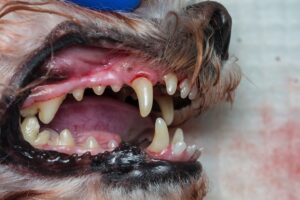
This article informs readers regarding the causes, symptoms, and treatment of a tooth root abscess in dogs.
Have you noticed your pet develop a swelling below its eye? If so, this could be a dog tooth abscess. Unfortunately, this condition may be painful for your canine companion. This article informs readers regarding the causes, symptoms, and treatment of a tooth root abscess in dogs.
What is it and What are the Causes?
A tooth root abscess is a serious infection near a tooth’s root. It typically happens due to bacteria entering through a broken or traumatized tooth. A tooth root abscess in dogs forms when bacteria enter the tooth’s exposed root canal. If the protective tooth enamel chips, the underlying dentin or even the pulp can be exposed. This allows the bacteria into the center of the tooth where it doesn’t belong. Since the body isn’t prepared to have bacteria in this location, the bacteria is able to replicate and cause an infection.
In dogs, tooth fractures most frequently occur due to chewing on hard things like antlers, ice cubes, bones, hard nylon toys, or cow or pig hooves. The most commonly affected tooth is the fourth premolar, also known as the carnassial tooth.
Also, a tooth root abscess in dogs might occur secondary to periodontal disease or gum disease. In this case, the infection doesn’t travel down to the bone via the tooth’s center. Instead, it tracks along the outside of the tooth through the tissues surrounding the root. This can affect any tooth.
Symptoms
Even though abscessed teeth are painful, dogs might not demonstrate obvious signs of pain. Instead, your canine friend might be reluctant to chew on his toys or pull away when someone feels his or her head on a certain side. In addition, some dogs will have halitosis (bad breath), while others will constantly paw or rub at the affected side of their face. If the abscessed tooth is the first molar or upper fourth premolar tooth, the tissue below the eye will typically swell. It may look like your dog has a small mass under his or her eye if left untreated, the abscess can burst leaving an open wound on your pet’s face. If swelling and infection have extended behind the eye, your pet might react with a painful response if you try to open his mouth.
Diagnosis and Treatment
There is a high degree of suspicion for a tooth root abscess when there is a draining tract below the chin, onto the face, or into the oral cavity. However, dental X-rays are needed to diagnose a tooth root abscess definitively. As for treatment, there are only two options: root canal therapy (preserves the tooth’s structure) or more commonly, extraction. Your vet will be the ideal person to recommend the appropriate option for your canine. This depends on the severity of the abscess and the degree of damage to the tooth and surrounding structures.
HERE AT MOUNT CARMEL ANIMAL HOSPITAL, WE’LL TREAT YOUR PETS LIKE FAMILY!
Mount Carmel Animal Hospital has been serving the Northern Baltimore/Southern York community for over 30 years and is proud to be an independently operated, small animal practice committed to excellence in veterinary medicine and client service. From grooming to wellness services, along with Canine Life Skills Training Courses, and surgical procedures, we have the expertise that will best serve the needs of you and your pet. Contact us at 410-343-0200 and follow us on Facebook!
